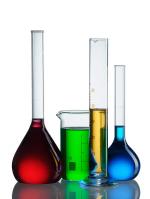|
This section contains 292 words (approx. 1 page at 300 words per page) |
Sonochemistry involves the study of chemical changes that occur as the direct result of sound or ultrasound waves traveling through either a homogeneous or heterogeneous liquid medium. The sound wave, as it passes through the solution, consists of expansion (negative- pressure) and compression (positive-pressure) waves. Expansion waves lead to formation of tiny bubbles, which may be filled with a dissolved gas, vapor of the liquid solvent or may be almost empty depending upon the pressure and the forces holding the liquid molecules together. The bubbles grow in size until they are collapsed rapidly by the compression region of the sound wave. The rapid collapse generates intense localized heating and associated high-energy chemistry. Effective temperatures within the gas-phase reaction zone may reach as high as 5000 K, and effective pressures of several hundreds of atmospheres have been reported. Localized heating produces significantly enhanced chemical reaction rates and increased product yields, and in some instances leads to chemicals that are unobtainable under ordinary reaction conditions.
Solid-liquid interfaces have also been subjected to ultrasound irradiation. Cavitation still occurs; however, the bubbles collapse asymmetrically directing a jet of liquid at the solid surface at velocities exceeding 100 meters/second. The liquid jet as it strikes the solid surface can cause localized erosion (and even melting) and surface pitting. The surface defects and deformations that are created give a highly reactive solid surface. The effects of ultrasound on liquid-solid interfaces has been a matter of intense investigation, particularly in applications involving organometallic reactions, development of heterogeneous catalytic systems, and activation of the lesser reactive metals. Also, ultrasound waves have been found to enhance mass transport near metal electrode surfaces. This latter observation has proved to be extremely useful in the synthesis of both organic and inorganic chalcogenides.
|
This section contains 292 words (approx. 1 page at 300 words per page) |


